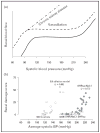Renal microvascular dysfunction, hypertension and CKD progression
- PMID: 23132368
- PMCID: PMC3942995
- DOI: 10.1097/MNH.0b013e32835b36c1
Renal microvascular dysfunction, hypertension and CKD progression
Abstract
Purpose of review: Despite apparent blood pressure (BP) control and renin-angiotensin system (RAS) blockade, the chronic kidney disease (CKD) outcomes have been suboptimal. Accordingly, this review is addressed to renal microvascular and autoregulatory impairments that underlie the enhanced dynamic glomerular BP transmission in CKD progression.
Recent findings: Clinical data suggest that failure to achieve adequate 24-h BP control is likely contributing to the suboptimal outcomes in CKD. Whereas evidence continues to accumulate regarding the importance of preglomerular autoregulatory impairment to the dynamic glomerular BP transmission, emerging data indicate that nitric oxide-mediated efferent vasodilation may play an important role in mitigating the consequences of glomerular hypertension. By contrast, the vasoconstrictor effects of angiotensin II are expected to potentially reduce glomerular barotrauma and possibly enhance ischemic injury. When adequate BP measurement methods are used, the evidence for BP-independent injury initiating mechanisms is considerably weaker and the renoprotection by RAS blockade largely parallels its antihypertensive effectiveness.
Summary: Adequate 24-h BP control presently offers the most feasible intervention for reducing glomerular BP transmission and improving suboptimal outcomes in CKD. Investigations addressed to improving myogenic autoregulation and/or enhancing nitric oxide-mediated efferent dilation in addition to the more downstream mediators may provide additional future therapeutic targets.
Conflict of interest statement
There are no conflicts of interest.
Figures




References
-
- Brenner BM, Lawler EV, Mackenzie HS. The hyperfiltration theory: a paradigm shift in nephrology. Kidney Int. 1996;49:1774–1777. - PubMed
-
- Hostetter TH, Olson JL, Rennke HG, et al. Hyperfiltration in remnant nephrons: a potentially adverse response to renal ablation. Am J Physiol. 1981;241:F85–93. - PubMed
-
- Griffin KA, Kramer H, Bidani AK. Adverse renal consequences of obesity. Am J Physiol Renal Physiol. 2008;294:F685–F696. - PubMed
-
- Bidani AK, Mitchell KD, Schwartz MM, et al. Absence of glomerular injury or nephron loss in a normotensive rat remnant kidney model. Kidney Int. 1990;38:28–38. - PubMed
-
- Griffin KA, Picken MM, Churchill M, et al. Functional and structural correlates of glomerulosclerosis after renal mass reduction in the rat. J Am Soc Nephrol. 2000;11:497–506. - PubMed
Publication types
MeSH terms
Substances
Grants and funding
LinkOut - more resources
Full Text Sources
Other Literature Sources
Medical
Research Materials

